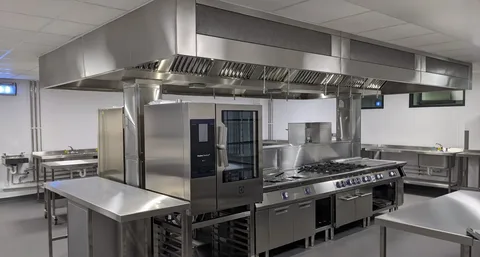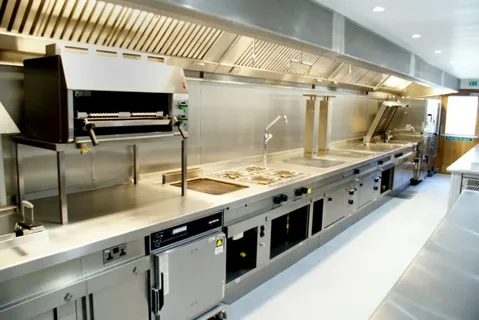When it comes to running a professional kitchen, having the right commercial catering-equipment is essential. These high-performance tools are the backbone of any successful food service operation, ensuring efficient and reliable operations day in and day out. Whether you run a restaurant, catering business, hotel, or any other food service establishment, investing in top-rated catering solutions can make all the difference in the world. In this blog post, we will explore the world of commercial catering equipment, its benefits, must-have tools, innovative trends in technology, choosing the right suppliers, the role of maintenance, efficient layout design, future-proofing your kitchen, and more. Let’s dive in!
Understanding Commercial Catering-equipment
Commercial Catering-equipment encompasses the extensive array of tools, appliances, and machinery specifically engineered for use in the demanding environments of professional kitchens. These items are crafted to endure the intense pace and pressures of the catering world, delivering unwavering performance to meet the expectations for high volume and exemplary quality. Unlike standard kitchen equipment, commercial-grade items are notable for their durability, larger capacity, and more robust construction.
This distinction ensures they can handle the rigors of daily, intensive use, which is a hallmark of food service operations. From sophisticated cooking appliances to advanced refrigeration solutions and specialized food preparation equipment, each piece plays a pivotal role in the smooth execution of kitchen tasks. Their design prioritizes not only functionality and reliability but also adherence to the strictest health and safety standards, making them indispensable allies in the quest to deliver exceptional culinary experiences.
 The Benefits of High-Quality Catering-equipment
The Benefits of High-Quality Catering-equipment
Investing in premier commercial Catering-equipment yields substantial rewards that transcend mere operational efficiency. Foremost among these is the pronounced enhancement of food quality. Chefs can consistently prepare dishes to the highest standard, utilizing precise temperature controls and cutting-edge technology that ensure culinary excellence. Furthermore, top-tier equipment markedly augments kitchen productivity. With faster cooking times and more streamlined processes, kitchens can serve more customers without compromising on quality. Safety and hygiene also see significant improvements, as superior equipment is designed with cleanliness and food safety regulations in mind, reducing the risk of contamination.
Additionally, energy efficiency is a hallmark of quality Catering-equipment, offering businesses an opportunity to reduce their environmental impact while also lowering operational costs. Ultimately, the choice of high-caliber Catering-equipment is a pivotal factor in enhancing customer satisfaction, streamlining kitchen operations, and bolstering the bottom line. This strategic investment not only propels kitchens towards greater success but also establishes a foundation for long-term sustainability and growth in the highly competitive food service industry.
Must-Have Catering-equipment for Professional Kitchens
Equipping a professional kitchen demands a careful selection of Catering-equipment that underpins the operational and culinary success of the establishment. Essential items encompass a range of appliances and tools designed to meet the diverse needs of a bustling kitchen. At the forefront are commercial ovens, which offer the versatility and power required for a multitude of cooking tasks, from baking to roasting. Refrigeration units are another cornerstone, ensuring that ingredients remain fresh and safe for consumption. These come in various forms, including upright fridges, under-counter units, and walk-in coolers, tailored to the size and scale of the operation.
Cooking ranges, equipped with multiple burners and possibly griddles or char broilers, are indispensable for their ability to handle a high volume of cooking with precision. Equally critical are food preparation stations, which provide a hygienic and efficient space for the preparation of ingredients. These stations are often modular, allowing for a customized layout that maximizes workflow and ergonomics.
Beyond these, there are specialized tools and appliances that may be considered essential based on the menu and service style of the establishment, such as mixers for bakeries or pasta machines for Italian restaurants. Each piece of equipment must be chosen with an eye towards durability, performance, and how it fits into the overall operation of the kitchen, ensuring that every dish can be prepared to the highest standard.
Innovative Trends in Catering-equipment Technology
The realm of commercial Catering-equipment is witnessing a significant technological evolution, with innovations aimed at enhancing kitchen efficiency, sustainability, and the culinary experience. One of the foremost trends is the integration of Iota (Internet of Things) capabilities, allowing for real-time monitoring and control of appliances, leading to improved energy management and predictive maintenance. Additionally, the rise of automation in food preparation and cooking processes is streamlining operations, reducing labor costs, and minimizing human error.
Energy efficiency continues to be a major focus, with new equipment models boasting advanced features that lower power consumption and reduce carbon footprints, aligning with the growing demand for greener kitchen practices. Furthermore, touch less technology is gaining traction, enhancing hygiene and safety in the kitchen by minimising contact points. These technological advancements are not just transforming the way kitchens operate but are also setting new standards in food service, offering establishments the opportunity to innovate and adapt in a rapidly changing industry landscape.
How to Choose the Right Catering equipment Suppliers?
Navigating the landscape of suppliers for Catering equipment demands a strategic approach to ensure the longevity and reliability of your kitchen’s operations. The foundation of a successful partnership lies in the selection of a supplier that not only delivers high-quality products but also exemplifies stellar customer service and support. It is advisable to conduct thorough research, seeking recommendations from industry peers and reading online reviews to gauge the reputation of potential suppliers.
Key considerations should include the breadth and quality of their product range, ensuring they offer the latest and most efficient technology to keep your kitchen at the forefront of culinary excellence. Additionally, examine the warranty and after-sales support services offered. A supplier that provides comprehensive warranty coverage and responsive, accessible after-sales support demonstrates a commitment to their products’ performance and your satisfaction over time. Competitive pricing, whilst important, should not be the sole criterion.
Value should be assessed in terms of the total cost of ownership, including energy efficiency, durability, and the potential savings from reduced downtime and repair costs. In your selection process, also priorities suppliers who understand and align with your specific needs and challenges. A supplier attuned to the nuances of your operation can offer invaluable advice and tailored solutions that significantly impact your kitchen’s efficiency and productivity. Engaging with the right supplier is a strategic step towards a more innovative, resilient, and successful culinary operation.
The Role of Maintenance in Extending Equipment Lifespan
The longevity and optimal performance of commercial Catering-equipment hinge significantly on regular maintenance. A disciplined approach to servicing, involving routine inspections and prompt repairs, safeguards against operational disruptions and enhances safety within the kitchen environment. It’s not merely about troubleshooting when issues arise; proactive maintenance anticipates potential failures before they escalate into costly problems. Engaging in such preventative measures entails detailed cleaning to avert the buildup of grease and debris, which can impair functionality and pose fire risks.
Additionally, calibration and adjustment of appliances ensure they operate within their intended specifications, conserving energy and reducing wear and tear. Implementing a structured maintenance plan, which includes keeping a log of all services and inspections, aids in monitoring equipment health and can significantly contribute to its longevity. By prioritizing maintenance, establishments can achieve a marked reduction in downtime and operational costs, underpinning the smooth running of the kitchen and maintaining high standards of food quality and safety. This disciplined upkeep is not just a technical requirement but a strategic asset in the longevity and reliability of catering operations.
Efficient Layout Design: Maximizing Space and Workflow
Crafting an efficient kitchen layout is paramount in optimizing both space and workflow, crucial elements that directly impact the productivity and functionality of any catering operation. Strategic equipment placement, mindful of ergonomics, allows for seamless movement and interaction among staff, thereby reducing the risk of accidents and enhancing operational efficiency. Thoughtful consideration should also be given to the sequence of food preparation areas, cooking stations, and cleaning zones to ensure a logical flow that mirrors the cooking process. Incorporating flexibility in the design can accommodate future changes or expansions, ensuring the kitchen layout remains adaptable to evolving business needs.
The incorporation of energy-efficient appliances and solutions, as highlighted in previous sections, further complements this design ethos by fostering a sustainable and cost-effective environment. Achieving a balance between utilizing every square meter of available space and maintaining an uncluttered, safe working environment is essential. This careful planning and design approach not only maximizes the efficiency of kitchen operations but also contributes to a more pleasant and productive working atmosphere for staff.
Future-Proofing Your Kitchen with Scalable Solutions
In an industry characterised by swift changes and evolving consumer preferences, ensuring your kitchen’s longevity necessitates a strategic approach to selecting scalable Catering-equipment. Embracing modular systems and multifunctional appliances offers the flexibility needed to adapt to future demands, be it through menu diversification or capacity augmentation. Investing in such adaptable solutions facilitates not only the expansion of service offerings but also streamlines operational efficiency, making it easier to introduce new culinary techniques or dishes without the need for significant overhauls.
This foresight in equipment choice allows for seamless scalability, enabling kitchens to respond dynamically to market trends and customer needs, thus safeguarding the establishment’s relevance and competitiveness. Moreover, prioritizing equipment with upgradable software or attachments can enhance functionality over time, offering a sustainable pathway to incorporating technological advancements and adhering to evolving regulatory standards without necessitating complete replacements. This approach ensures that your kitchen remains at the forefront of innovation, prepared to meet both current and future challenges with agility and confidence.
Conclusion
Selecting the finest commercial catering equipment is a pivotal decision for any food service establishment aiming to enhance its operational efficiency and culinary output. The journey to a well-equipped and high-functioning kitchen demands attention to detail in every aspect, from choosing cutting-edge tools that align with contemporary culinary trends to ensuring these investments are maintained with utmost diligence. Engaging with these principles provides not only a blueprint for immediate success but also secures a resilient and forward-thinking approach to catering that will serve your business well into the future.
FAQs
Q: What are the key types of equipment every commercial kitchen should invest in?
A: Every commercial kitchen should priorities investment in robust commercial ovens, reliable refrigeration solutions to keep ingredients at optimal freshness, versatile cooking ranges for varied cooking methods, and ergonomically designed food preparation stations to streamline the prep process.
Q: How vital is the role of maintenance in the longevity of Catering-equipment?
A: Maintenance plays a pivotal role in the longevity and efficiency of Catering-equipment. Regular servicing and timely repairs can significantly extend the lifespan of your equipment, ensuring it operates at peak performance, reduces the likelihood of costly downtime, and maintains the highest safety and hygiene standards.
Q: Can you highlight some of the most recent technological advancements in commercial Catering-equipment?
A: The landscape of commercial Catering-equipment is rapidly evolving with technological advancements designed to enhance operational efficiency and sustainability. Key trends include the integration of Iota for real-time monitoring and control, automation to streamline food preparation and reduce labor costs, energy-efficient models that lower operational expenses and support greener practices, and the adoption of touch less technologies to improve hygiene and safety measures in the kitchen.
Q: How does choosing the right equipment suppliers impact kitchen operations?
A: Selecting the right equipment suppliers is critical for ensuring you have access to high-quality, durable, and efficient kitchen solutions. Reputable suppliers offer not only top-of-the-line products but also comprehensive after-sales support, including responsive service and maintenance assistance, which is indispensable for the smooth and uninterrupted operation of a commercial kitchen.
| Other Good Articles to Read |
| Blogs-Peoples |
| Bryan Smith Blogs |
| intellect blogs |
| the fault in our blogs |
| blogs eu |
| oz forums |
| recruitment blogs |
| zet blogs |
| id blogs |
| Blog Studio legale |
| blogs map |
| Related Business Listings |
| Contact Directory |
| Local Business Profiles |



